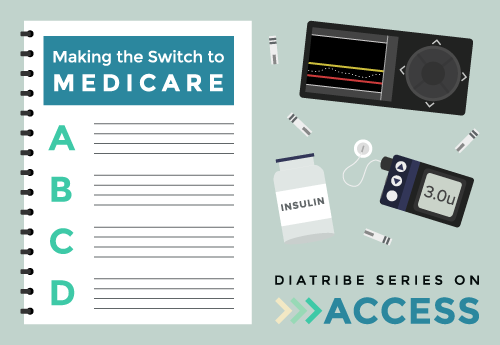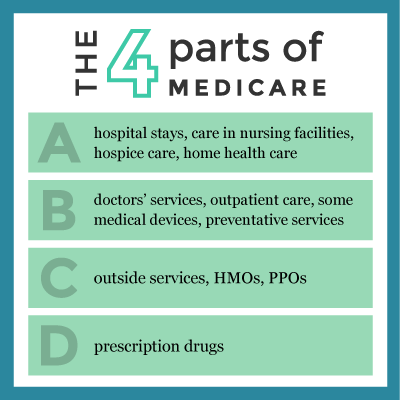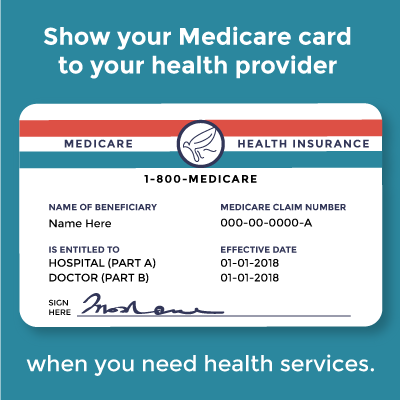Making the Switch to Medicare with Diabetes
By Jeemin Kwon
 By Pearl Subramanian and Jeemin Kwon
By Pearl Subramanian and Jeemin Kwon
From enrolling in the four types of plans to what they cover, everything you need to know when making the switch to Medicare with diabetes
Editor's note: This article was updated in December 2019.
Leer este artículo en español.
Despite covering 61 million Americans in 2019, Medicare can be difficult to navigate. The US-government-run program provides health coverage to people over the age of 65 and to those under 65 who have certain disabilities or other conditions. If you are ready to make the switch over to Medicare or know someone who is, this article is a guide on what you need to know for as smooth a transition as possible, understanding that there are plenty of complexities here!
Click to jump to a section:
About Medicare
Though Medicare is often thought of as one big plan, it actually has four different types of coverage:
-
Part A covers hospital stays, care in nursing facilities, hospice care, and home health care.
-
Part B covers doctors’ services, non-hospital (outpatient) care, some medical devices and preventative services. People pay a monthly premium for this coverage.
-
Part C allows people the option to enroll in private insurance plans (HMOs and PPOs) and to receive their benefits under Parts A and B. Those plans are called Medicare Advantage, and most offer additional benefits such as dental and vision.
-
Part D covers prescription drugs and is optional with an additional monthly fee.
For more information on decoding and understanding health insurance language, check out diaTribe’s guide here.
 Medicare and Diabetes
Medicare and Diabetes
Medicare covers certain benefits and supplies specific to people with diabetes, including diabetes drugs, blood glucose monitoring equipment, insulin delivery devices, and therapeutic shoes/inserts. Refer to Medicare and Diabetes Coverage for additional information regarding these provisions, and see the table below to learn which specific benefits and supplies are covered under Medicare.
Helpful Tips for Medicare and Diabetes:
-
Enroll in Part B and Part D. Part A is limited to home care and care in medical facilities, but Parts B and D will cover many of the supplies you may need. Insulin, insulin pumps and CGM, (which fall under the Medicare Part B section for “durable medical equipment”) and prescription diabetes drugs (Part D) are some of the benefits under Parts B and D. Alternatively, you may choose to enroll in a Medicare Advantage plan (Part C) that includes Part D benefits.
-
People with Medicare who do not use insulin are limited to 100 strips and lancets every three months under Part B (check out these tips on how to get more strips on a budget). Certain insulin users might also qualify to use continuous glucose monitoring (CGM), given the recent approval of Dexcom’s G5 – get more details here.
.png)
If you use insulin, make sure you ask for the 300 test strips and lancets every three month. If you do not use insulin, make sure you ask for 100 strips and lancets every three months.
-
When choosing a pharmacy, make sure you pick a Medicare-insured pharmacy that accepts assignment for Medicare-covered supplies. This will save you plenty of money in the long term. If a pharmacy does not accept assignment, you will have to pay the assignment fee in addition to the cost of your medicine. In this case, you will usually have to pay the total cost up-front and wait for Medicare to send you a reimbursement of its share of the cost. Additionally, if you fill your prescription at a non-Medicare supplier pharmacy, you will have to pay the entire bill for the supplies – Medicare won’t cover anything.
.png) Find a pharmacy that accepts assignment for Medicare-covered supplies online here. Enter your zip code to get started and then check off the boxes for the supplies you need.
Find a pharmacy that accepts assignment for Medicare-covered supplies online here. Enter your zip code to get started and then check off the boxes for the supplies you need.
Navigating Medicare Enrollment:
How do I get parts A and B?
If you will be getting benefits from Social Security or the Railroad Retirement Board (RRB) at least 4 months before turning 65:
-
 You will be automatically signed up for Part A and Part B, with coverage starting the first day of the month you turn 65.
You will be automatically signed up for Part A and Part B, with coverage starting the first day of the month you turn 65. -
If your birthday is on the first of the month, your Part A and B coverage starts the first day of the prior month.
-
You should receive your red, white, and blue Medicare card by mail 3 months before your 65th birthday. This is what you can show to your healthcare provider when you need health services.
If you will not be getting benefits from Social Security (or the RRB) at least 4 months before turning 65:
-
To enroll in Parts A and B, you can apply through Social Security if you are at least 64 years and 9 months old.
-
The online application can be found here, or you can go to your local social security office and apply in-person (use this tool to find your nearest office).
Note: If you are under 65 years and have a disability, have ALS (Lou Gehrig’s disease), or end-stage renal disease (ESRD), you are also eligible for Medicare coverage. See this website for more information on how to make sure you have coverage.
Can I sign up for only Part A or Part B?
While Part A does not have any monthly premiums (fees that you pay out-of-pocket to be in a health insurance plan), Part B does have monthly premiums. Therefore, you can enroll in Part A and decline Part B. However, it is generally recommended to enroll in Part B when you first become eligible to avoid late enrollment fees and higher premiums that you would face if you delay enrollment to a later time. Part B also covers “durable medical equipment” such as insulin pumps.
If you are signed up for both Social Security and Medicare Part B, the premium cost from Part B will automatically be deducted from your monthly Social Security benefit. On average, Part B premiums range from $135.50 per month (if you pay the premium through your monthly Social Security benefits) all the way to $460.50 per month depending on your yearly income.
In 2019, you will pay $185 for your Part B deductible. After your deductible is met, you will pay 20% of the Medicare approved amount for most drugs, services, and supplies. See the table below for more details on what you pay.
.png) People with low incomes may qualify for a Medicare Savings Program to help offset premiums and copays. Though eligibility requirements vary, most program income limits range from $1,000 to $1,400 a month for individuals and $1,400 to $1,900 a month for married couples.
People with low incomes may qualify for a Medicare Savings Program to help offset premiums and copays. Though eligibility requirements vary, most program income limits range from $1,000 to $1,400 a month for individuals and $1,400 to $1,900 a month for married couples.
How do I get prescription drug coverage?
To get prescription drug coverage under Medicare, you can enroll in Part C or Part D.
Part D coverage:
Part D offers a voluntary outpatient prescription drug benefit to Medicare beneficiaries, including those enrolled in Medicare Advantage plans, and the monthly premium is determined by your income level. Under Part D, there are a variety of plans that cover different sets of drugs.
.png) To find a plan that covers the drug you need, use this tool to filter by criteria such as your location, current Medicare coverage, list of drugs you use, and pharmacies in your area.
To find a plan that covers the drug you need, use this tool to filter by criteria such as your location, current Medicare coverage, list of drugs you use, and pharmacies in your area.
To get Part D coverage, enroll in the Medicare Plan Finder or on the plan’s website. When enrolling, you can find information about your Medicare number and the date your Part A and/or Part B coverage started on your red, white, and blue Medicare card. Subsidies are available for certain beneficiaries with low incomes.
Part C coverage:
Medicare Part C, also known as the Medicare Advantage Plan, is health coverage that Medicare offers through contracts with private insurance companies. Medicare Advantage Plans also cover prescription drugs and may be preferable to Part D because of lower premiums and additional benefits such as vision and dental. Remember that you will still need to pay your monthly premiums for Part B. However, each plan varies in terms of out of pocket costs.
Many Advantage plans also cover care overseas, which is an advantage if you travel often. You can use the same tool to search Part D plans to search for Medicare Advantage Plans and enroll.
.png) If you already have a Medicare number, use this tool to check your current and potential for future enrollment
If you already have a Medicare number, use this tool to check your current and potential for future enrollment
Medicare Coverage of Diabetes Services and Supplies
| Supply/Service | What's Covered | What You Pay |
|---|---|---|
|
Diabetes drugs |
Medicare Part D covers diabetes drugs for managing blood sugar (glucose). |
Coinsurance or copayment; Part D deductible may also apply. |
|
Insulin |
Medicare Part D covers insulin that isn’t administered with an insulin pump. (See below for insulin pumps) |
Coinsurance or copayment; Part D deductible may also apply. |
|
Diabetes screenings |
Medicare Part B covers screenings if your doctor determines you’re at risk for diabetes. You may be eligible for up to two diabetes screenings each year. |
No coinsurance, copayment, or Part B deductible for screenings. Generally, 20% of the Medicare‑approved amount after the yearly Part B deductible for the doctor’s visit. This means that even after you meet your deductible (the yearly out-of-pocket amount you pay before your insurance begins to cover expenses), you still pay 20% of the cost of the doctor’s visit. |
|
Diabetes self-management training (DSMT) |
DSMT helps you develop skills to manage your diabetes. Part B covers DSMT services for people recently diagnosed with diabetes or at risk for complications from diabetes. Your doctor or other health care provider must order the DSMT services and they must be provided by an accredited individual or entity, or program. If you are in a rural area, you may be able to get DSMT services from a different location through telehealth services. Use this tool to find a certified diabetes educator near you. |
20% of the Medicare‑approved amount after the yearly Part B deductible. |
|
Diabetes equipment and supplies |
Part B covers home blood sugar (glucose) monitors and supplies used with the equipment, including blood sugar test strips, lancet devices, and lancets. There may be limits on how much or how often you get these supplies. |
20% of the Medicare‑approved amount after the yearly Part B deductible. |
|
Insulin pumps |
Medicare Part B covers external durable insulin pumps and the insulin that the device uses under durable medical equipment if you have type 1 diabetes, are on multiple daily injections, have completed a comprehensive diabetes education program, and meet one of the following criteria: A1c greater than 7.0%, history of hypoglycemia, wide fluctuations in blood sugar before mealtime, fasting blood sugars frequently greater than 200 mg/dl, or history of severe blood sugar fluctuations (see this page for more detail). |
20% of the Medicare‑approved amount after the yearly Part B deductible. |
|
Continuous glucose monitor (CGM) |
The Dexcom G5 CGM is covered under Part B. Some of the eligibility requirements include use of a blood glucose monitor and testing four or more times a day and taking multiple daily injections (or continuous subcutaneous infusions) of insulin. See Dexcom’s website for more info. |
20% of the Medicare-approved amount after the yearly Part B deductible, approximately $48 per month. |
|
Diabetes supplies |
Part D covers certain medical supplies to administer insulin (like syringes, needles, alcohol swabs, gauze, and inhaled insulin devices). |
Coinsurance or copayment; Part D deductible may also apply. |
|
Foot exams and treatment |
Part B covers a foot exam every six months for people with diabetic peripheral neuropathy and loss of protective sensation, as long as they haven’t seen a foot care professional for another reason between visits. |
20% of the Medicare‑approved amount after the yearly Part B deductible. |
|
Glaucoma (eye condition from optic nerve damage) tests |
Part B covers this test once every 12 months for people at high risk for glaucoma. You’re considered high risk for glaucoma if you have diabetes, or a family history of glaucoma, or are African‑American and over 50, or are Hispanic and over 65. Tests must be done by an eye doctor legally authorized by the state. |
20% of the Medicare‑approved amount after the yearly Part B deductible. |
|
Medical nutrition therapy services (MNT) |
Part B may cover medical nutrition therapy (MNT) and certain related services if you have diabetes or kidney disease. MNT services may include an initial nutrition and lifestyle assessment, one-on-one nutritional counseling, and follow-up visits with a Registered Dietician or nutrition professional. Your doctor or other health care provider must refer you for the MNT services. |
No copayment, coinsurance, or Part B deductible if your doctor or health care provider accepts assignment. |
|
Therapeutic shoes or inserts |
Part B covers therapeutic shoes or inserts for people with diabetes who have severe diabetic foot disease. The doctor who treats your diabetes must certify your need for therapeutic shoes or inserts. The shoes and inserts must be prescribed by a podiatrist or other qualified doctor and provided by a podiatrist, orthotist, prosthetist, or pedorthist. |
20% of the Medicare‑approved amount after the yearly Part B deductible. |
|
"Welcome to Medicare" preventative visit |
Part B covers a one‑time review of your health, and education and counseling about preventive services, including certain screenings, shots, and referrals for other care, if needed. Note: You must have the visit within the first 12 months you have Part B. |
No copayment, coinsurance, or Part B deductible if your doctor or health-care provider accepts assignment. |
|
Yearly "wellness" visit |
If you’ve already had Part B for longer than 12 months, you can get a yearly “Wellness” visit to develop or update a personalized prevention plan based on your current health and risk factors. If you had a “Welcome to Medicare” visit, you’ll have to wait 12 months before you can get your first yearly “Wellness” visit. |
No copayment, coinsurance or Part B deductible if your doctor or health-care provider accepts assignment. |
Stay tuned for a guide on navigating the Medicare appeals process!
Medicare Supplement Plans
In general, Medicare will cover about 80% of approved costs. Many individuals opt or Medicare supplement plans, also known as Medigap plans, which help cover the remaining costs.
Starting in January 2020, individuals who enroll in Medicare will not be able to purchase Medicare supplement plans that cover Medicare Part B. These plans are Medicare Supplement Plan F, Plan F High-Deductible, and Plan C. If you enrolled in Medicare Part A by December 31, 2019, you can still keep your supplemental plan or even apply for one in 2020.
The most common supplemental plan is Plan G, which you will still be able to apply for in 2020. Just note that Plan G will not cover the deductible of Part B.
Stay tuned for a guide on navigating the Medicare appeals process!
.png) This article is part of a series on access that was made possible by support from Lilly Diabetes. The diaTribe Foundation retains strict editorial independence for all content.
This article is part of a series on access that was made possible by support from Lilly Diabetes. The diaTribe Foundation retains strict editorial independence for all content.







